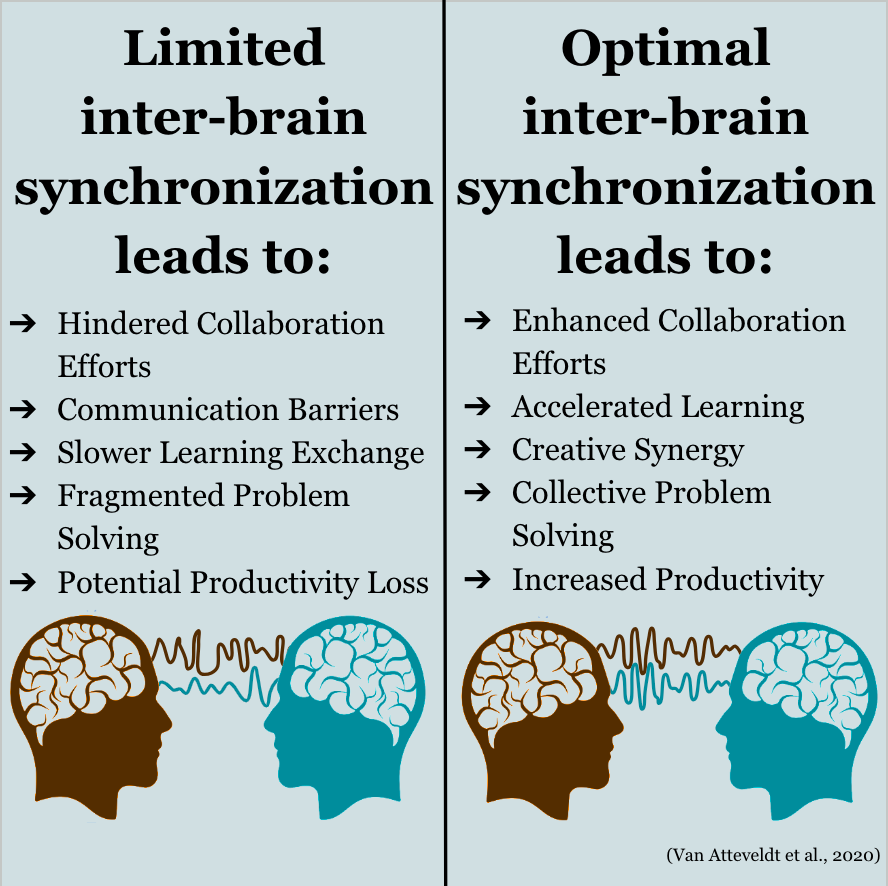Have you ever felt an immediate connection with someone you just met? It's almost as if your brains are communicating and sending messages to each other to gauge your comfort and safety with that individual. It is not uncommon for this sensation to extend beyond mere personal connections; people can subconsciously match their footsteps when walking in a group and audiences' heartbeats can synchronize during live performances. Recently, this intriguing phenomenon has been further explored through the concept of inter-brain synchronization. This occurs when the neural activity in multiple brains becomes synchronized with one another.
Neurons, which are the most fundamental units of the brain and the nervous system, are at the core of inter-brain synchronization. There are approximately one hundred billion neurons in a mature human brain that rapidly transmit information to one another and throughout the body using chemical signals and electrical impulses. Known as neural oscillations, these electrical activities in the brain occur at different frequencies and are categorized into various bands. These can range from low frequencies like delta (<4 Hz), theta (4–8 Hz), alpha (8–12 Hz), and beta (12-30 Hz) to high frequencies like gamma (30–80 Hz) and high gamma (>80 Hz) (Moran et al., 2011). Understanding inter-brain synchronization involves subjects participating in activities that challenge them cognitively. Researchers generally utilize various techniques, such as functional magnetic resonance imaging (fMRI) and functional near-infrared spectroscopy (fNIRS) in order to study inter-brain synchronization. These methods measure oxygen levels in blood flow, providing valuable insights into brain activity. Additionally, a test called an electroencephalogram (EEG) is also employed, which involves attaching small metal disks, known as electrodes, to the scalp. By doing so, the basic waveforms and overall electrical activity of the brain can be precisely measured.
A study included in Psychological Science aimed to explore inter-brain synchronization between students and their instructors and its impact on students' learning and performance (Davidesco et al., 2023). An EEG was put to use to track brain activity in both the teacher and students. During four seven-minute scientific lectures on biology and chemistry, students attentively listened, and after each lecture, a brief assessment was administered. As students paid attention and engaged with the lecture, their alpha oscillations aligned not only with each other but also with those of the teacher. Previous research has indicated that aligning alpha oscillations has been associated with inhibitory control and attention. Thus, students whose alpha oscillations synchronized more with both their peers and the teacher ultimately exhibited enhanced learning, leading to higher test scores. Similarly, another study in the scientific journal Social Cognitive and Affective Neuroscience divided participants into coordination and independence groups (Hu et al., 2017). These groups were asked to perform a task for which they had to press keys simultaneously with their partner or a computer, respectively, after counting a given time in their minds. Their brain activity was recorded using functional near-infrared spectroscopy (fNIRS) hyperscanning, showing that the coordination group displayed higher synchronized behaviors and significant task-related brain coherence. Conducting such studies enables scientists to understand the mechanisms underlying why teams are much more coordinated and often outperform individuals in different activities when compared to working alone (Reinero et al., 2021).

Although inter-brain synchronization is a relatively new and developing field of research, it holds immense potential. It is a powerful discovery that helps the scientific community uncover information regarding how individuals form connections, learn from each other, cooperate, and exhibit helpfulness and other prosocial behaviors. Through additional exploration, invaluable insights can positively impact various fields, from education and teamwork to interpersonal relationships and societal well-being. So next time you feel a connection with someone, don’t forget to owe it to inter-brain synchronization!
References
Audience members’ hearts beat together at the theatre. (2019). https://www.ucl.ac.uk/pals/news/2017/nov/audience-members-hearts-beat-together-theatre
Davidesco, I., Laurent, E., Valk, H., West, T., Milne, C., Poeppel, D., & Dikker, S. (2023). The Temporal Dynamics of Brain-to-Brain Synchrony Between Students and Teachers Predict Learning Outcomes. Psychological science, 34(5), 633–643. https://doi.org/10.1177/09567976231163872
Denworth, L. (2023). Brain waves synchronize when people interact. https://www.scientificamerican.com/article/brain-waves-synchronize-when-people-interact/
Feehly, C. (2021). Brains might sync as people interact - and that could upend consciousness research. https://www.discovermagazine.com/mind/brains-might-sync-as-people-interact-and-that-could-upend-consciousness
Hu, Y., Hu, Y., Li, X., Pan, Y., & Cheng, X. (2017). Brain-to-brain synchronization across two persons predicts mutual prosociality. Social cognitive and affective neuroscience, 12(12), 1835–1844. https://doi.org/10.1093/scan/nsx118
Klimesch W. (2018). The frequency architecture of brain and brain body oscillations: an analysis. The European journal of neuroscience, 48(7), 2431–2453. https://doi.org/10.1111/ejn.14192
Moran, L. V., & Hong, L. E. (2011). High vs low frequency neural oscillations in schizophrenia. Schizophrenia bulletin, 37(4), 659–663. https://doi.org/10.1093/schbul/sbr056
Nachiappan, Y. (2023). Inter-brain synchrony in the social world: A family resemblance model. Retrieved from https://ojs.stanford.edu/ojs/index.php/intersect/article/view/2511
Neurons: How the brain communicates. (n.d.). https://mhanational.org/neurons-how-brain-communicates
Reinero, D. A., Dikker, S., & Van Bavel, J. J. (2021). Inter-brain synchrony in teams predicts collective performance. Social cognitive and affective neuroscience, 16(1-2), 43–57. https://doi.org/10.1093/scan/nsaa135
Van Atteveldt N, Janssen T and Davidesco I (2020) Measuring Brain Waves in the Classroom. Front. Young Minds. 8:96. doi:10.3389/frym.2020.00096
Zhang M, Jia H, Zheng M. Interbrain synchrony in the expectation of cooperation behavior: A hyperscanning study using functional near-infrared spectroscopy. Front Psychol (2020) 11:542093. doi:10.3389/fpsyg.2020.542093
